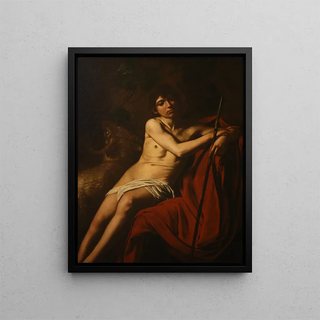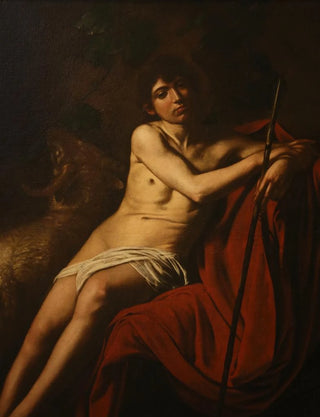Art print | Saint Jean-Baptiste - Caravaggio


View from behind

Frame (optional)
Saint John the Baptist - Caravaggio – Captivating Introduction
The "Saint John the Baptist" art print by Caravaggio is an iconic piece that embodies the depth and complexity of Baroque art. Created in the early 17th century, this masterful work draws the viewer's eye through its bold use of light and shadow, creating a striking contrast that brings the figure of the saint to life. John the Baptist, clothed in animal skins, is depicted in a moment of introspection, with his posture and expression conveying a rare emotional intensity. This art print does not merely depict a religious scene; it also invites the viewer to contemplate spirituality and the human condition, universal themes that resonate across ages.
Style and uniqueness of the work
Caravaggio's style is immediately recognizable, and "Saint John the Baptist" is a perfect illustration of this. The artist employs chiaroscuro to create a dramatic atmosphere, where light seems to emerge from darkness, illuminating the saint's face while plunging the rest of the composition into mysterious shadow. This technique, which plays on contrasts, allows focus on the character's features, enhancing their expressiveness. The saint's gestures, both gentle and powerful, suggest inner tension, a struggle between the material world and the divine. Caravaggio succeeds in capturing profound humanity in his figures, making his characters accessible and touching, while maintaining their sacredness.
The artist and his influence
Michelangelo Merisi da Caravaggio, known as Caravaggio, is one of the most influential artists of his time. His innovative approach to painting revolutionized artistic conventions at the end of the 16th century and the beginning of the 17th century. Moving away from classical ideals of beauty, he chose to depict realistic figures, often from the lower classes, in religious scenes. This humanization of saintly characters marked a turning point in art history, inspiring many artists across Europe. Caravaggio not only influenced the Baroque but his legacy endures in later artistic movements, demonstrating the power of his work.

Matte finish

View from behind

Frame (optional)
Saint John the Baptist - Caravaggio – Captivating Introduction
The "Saint John the Baptist" art print by Caravaggio is an iconic piece that embodies the depth and complexity of Baroque art. Created in the early 17th century, this masterful work draws the viewer's eye through its bold use of light and shadow, creating a striking contrast that brings the figure of the saint to life. John the Baptist, clothed in animal skins, is depicted in a moment of introspection, with his posture and expression conveying a rare emotional intensity. This art print does not merely depict a religious scene; it also invites the viewer to contemplate spirituality and the human condition, universal themes that resonate across ages.
Style and uniqueness of the work
Caravaggio's style is immediately recognizable, and "Saint John the Baptist" is a perfect illustration of this. The artist employs chiaroscuro to create a dramatic atmosphere, where light seems to emerge from darkness, illuminating the saint's face while plunging the rest of the composition into mysterious shadow. This technique, which plays on contrasts, allows focus on the character's features, enhancing their expressiveness. The saint's gestures, both gentle and powerful, suggest inner tension, a struggle between the material world and the divine. Caravaggio succeeds in capturing profound humanity in his figures, making his characters accessible and touching, while maintaining their sacredness.
The artist and his influence
Michelangelo Merisi da Caravaggio, known as Caravaggio, is one of the most influential artists of his time. His innovative approach to painting revolutionized artistic conventions at the end of the 16th century and the beginning of the 17th century. Moving away from classical ideals of beauty, he chose to depict realistic figures, often from the lower classes, in religious scenes. This humanization of saintly characters marked a turning point in art history, inspiring many artists across Europe. Caravaggio not only influenced the Baroque but his legacy endures in later artistic movements, demonstrating the power of his work.






